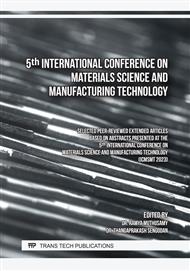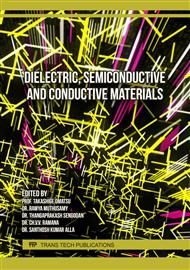[1]
D. Lyon and A. Hubler, Gap size Gap size dependence of the dielectric strength in nano vacuum gaps, IEEE Transactions on Dielectrics and Electrical Insulation, 20 (2013) 1467-1471.
DOI: 10.1109/tdei.2013.6571470
Google Scholar
[2]
R. Lyddy, Information resources in toxicology (fourth edition), Academic press 2009, 321-328.
Google Scholar
[3]
S. Srinivasan, A. M. Kannan, N. Kothurkar, Y. Khalil, S. Kuravi. Nanomaterials for Energy and Environmental Applications, J. of Nanomaterial (2015)
DOI: 10.1155/2015/979026
Google Scholar
[4]
K M. S. Siddiki, S. P. Singh. Reinforcement of Clay Material Doped with Metal-Oxide Nano-Material, International Journal for Research in Applied Science & Engineering Technology (IJRASET), 8 (2020)
DOI: 10.22214/ijraset.2020.4191
Google Scholar
[5]
Km Sushama and S. P. Singh. Synthesis and characterization of zinc sulphide nanoparticles, AIP Conference Proceedings LLC (2020)
DOI: 10.1063/5.0001594
Google Scholar
[6]
Ö. YAĞCİ, Electrochemical, Optical and Morphological Characterizations of Cu Doped ZnO Nanostructure Thin Films Prepared by Spin Coating Method, AKU J. Sci. Eng. 21 (2021) 1306-1314
DOI: 10.35414/akufemubid.888530
Google Scholar
[7]
A. Mahmoud, M. Echabaane, K. Omri, J. Boudon, L. Saviot, N. Millot, R. B. Chaabane, Cu-Doped ZnO Nanoparticles for Non-Enzymatic Glucose Sensing, Molecules, 26 (2021) 929.
DOI: 10.3390/molecules26040929
Google Scholar
[8]
J. Chauhan, N. Shrivastav, A. Dugaya, D. Pandey, Synthesis and characterization of Ni and Cu doped ZnO, MOJ Poly Sci.1(1) (2017) 26‒34.
Google Scholar
[9]
B.M. Savi, L. Rodrigues, A.M. Bernardin. Synthesis of ZnO Nanoparticles by Sol-gel processing, 55 Brazilian congress on ceramics, Brazil (2011)
Google Scholar
[10]
S. G. Kumar, R. Kavitha, and C. Sushma. Doped zinc oxide nanomaterials: structure–electronic properties and photocatalytic applications, Interface Science and technology, 31 (2020) 285-312.
DOI: 10.1016/b978-0-08-102890-2.00009-9
Google Scholar
[11]
B.S. Li, Z.Y. Xiao, J.G. Ma, and Y.C. Liu, Chin. The p-type ZnO thin films obtained by a reversed substitution doping method of thermal oxidation of Zn3N2 precursors, Phys. B, 26 (2017).
DOI: 10.1088/1674-1056/26/11/117101
Google Scholar
[12]
J. Jie, G. Wang, Q. Wang, Y. Chen, X. Han, X. Wang, J. G. Hou. Synthesis and characterization of aligned ZnO nanorods on porous aluminum oxide template; J Phys Chem B, 108 (2004) 11976-11980.
DOI: 10.1021/jp048974r
Google Scholar
[13]
J. C. Johnson, K. P. Knutsen, H. Yan, M. Law, Y. Zhang, P. Yang, R. J. Saykally. Ultrafast carrier dynamics in single ZnO nanowire and nanoribbon lasers, Nano Lett. 4 (2003) 197-204.
DOI: 10.1021/nl034780w
Google Scholar
[14]
M. J. Chithra and K. Pushpanathan. Thermal, structural and optical investigation of Cu-doped ZnO nanoparticles, Modern Physics Letters B, 30 (2016) 1650406.
DOI: 10.1142/s0217984916504066
Google Scholar
[15]
S. Muthukumaran, R. Gopalakrishnan. Structural, FTIR and photoluminescence studies of Cu doped ZnO nanopowders by co-precipitation method, Optical Materials, 34 (2012) 1946–1953.
DOI: 10.1016/j.optmat.2012.06.004
Google Scholar
[16]
J.Q. Hu, Q. Li, N.B. Wong, C.S. Lee, S.T. Lee. Synthesis of uniform hexagonal prismatic ZnO whiskers, Chem. Mater. 14 (2002) 1216–1219.
DOI: 10.1021/cm0107326
Google Scholar
[17]
M.S. Niasari, F. Davar, A. Khansari. Nanosphericals and nanobundles of ZnO: synthesis and characterization, J. Alloys Compd. 509 (2011) 61–65.
DOI: 10.1016/j.jallcom.2010.08.060
Google Scholar
[18]
R. Savu, R. Parra, E. Joanni, B. Jancar, S.A. Elizario, R. de Camargo, P.R. Bueno, J.A. Varela, E. Longo, M.A. Zaghate. The effect of cooling rate during hydrothermal synthesis of ZnO nanorods, J. Crys. Growth, 311 (2009) 4102–4108.
DOI: 10.1016/j.jcrysgro.2009.06.039
Google Scholar
[19]
J.Y. Lao, J.Y. Huang, D.Z. Wang, Z.F. Ren. ZnO nanobridges and nanonails; Nano Lett. 3 (2003) 235–238.
DOI: 10.1021/nl025884u
Google Scholar
[20]
A R Bari, M D Shinde, Vinita Deo & L A Patil. Effect of solvents on the particle morphology of nanostructured ZnO; Indian Journal of Pure & Applied Physics, 47 (2009) 24-27.
Google Scholar
[21]
S. Jurablu, M. Farahmandjou, and T. P. Firoozabadi. Sol-gel synthesis of zinc oxide (ZnO) nanoparticles: study of structural and optical properties; Journal of Sciences, Islamic Republic of Iran 26(3) (2015) 281 - 285.
Google Scholar
[22]
D. bresser, F. Mueller, M. Fiedler, S. Krueger, R. Kloepsch, D. Baither, M. Winter, E. Paillard, S. Passerini. Transition-metal-doped zinc oxide nanoparticles as a new lithium-ion anode material, J.Chem mater, 25 (2013) 4977.
DOI: 10.1021/cm403443t
Google Scholar
[23]
M. Fu, Y. Li, Siweiwu, P. lu, J. Liu, Fandong. Sol gel preparation and enhanced photocatalytic performance of Cu doped ZnO Nanoparticles, Applied surface science 258 (2011) 1587-1591.
DOI: 10.1016/j.apsusc.2011.10.003
Google Scholar
[24]
M. Sajjad, I. Ullah, M.I. Khan, J. Khan, M. Y. Khan, M. T. Qureshi. Structural and optical properties of Copper doped Zinc Oxide Nanoparticles. (2018) 1301-1309.
DOI: 10.1016/j.rinp.2018.04.010
Google Scholar
[25]
J.N. Hasnidawani, H.N. Azlina, H.Norita, N.N. Bonnia, S.Ratim and E.S. Ali. Synthesis of ZnO Nanostructures Using Sol-gel Method. (2015) Doi.org/
DOI: 10.1016/j.proche.2016.03.095
Google Scholar
[26]
A. K. Radzimska and T. Jesionowski. Zinc Oxide-From Synthesis to Application: A Review Materials, 7(4) (2014) 2833-2881.
DOI: 10.3390/ma7042833
Google Scholar
[27]
J.B baxter and E.S Aydil. Nanowire based dye-sensitized solar cell. Appl. phys. Lett. 86 (2005) 53114.
DOI: 10.1063/1.1861510
Google Scholar
[28]
M. H. Huang, S. Mao, H. Feick, H. Q. Yan, Y. Wu, H. Kind, E. Weber, R. Russo, and P. Yang. Room-Temperature Ultraviolet Nanowire Nanolasers, Science, 292 (2001) 1897-1899.
DOI: 10.1126/science.1060367
Google Scholar
[29]
J. Song, J. Zhou, and Z. L. Wang. Piezoelectric and Semiconducting Coupled Power Generating Process of a Single ZnO Belt/Wire. A Technology for Harvesting Electricity from the Environment, Nano Lett. 6 (2006) 1656-1662.
DOI: 10.1021/nl060820v
Google Scholar
[30]
Z. L. Wang. Functional oxide nanobelts: materials, properties and potential applications in nanosystems and biotechnology; Annual Review of Phys. Chem. 55 (2004) 159-196.
DOI: 10.1146/annurev.physchem.55.091602.094416
Google Scholar
[31]
J. Sawai, H. Igarashi, A. Hashimoto, T. Kokugan, and M. Shimizu. Effect of ceramic powder slurry on spores of Bacillussubtilis, Journal of Chemical Engineerng of Japan, 28 (1996) 556-561.
DOI: 10.1252/jcej.28.556
Google Scholar
[32]
M. Vaseem, A. Umar, Y. B. Hahn. ZnO Nanoparticles: Growth, Properties, and Applications, American Scientific publishers, 5 (2010) 1-36.
Google Scholar
[33]
K. Yung, H. Ming, C. Yen, & H. Chao. Synthesis of 1D,2D and 3D ZnO polycrystalline Nanostructructures using Sol-gel Method, Journal of Nanotechnology (2012) https://doi:.org/.
DOI: 10.1155/2012/712850
Google Scholar
[34]
K. Mohibul, Synthesis and Characterization of Copper Doped Zinc Oxide Thin Films Deposited by RF / DC Sputtering Technique, 28 (2023) 172–179.
Google Scholar
[35]
M. Sajjad, I. Ullah, M.I. Khan, J. Khan, M.Y. Khan, M. Tauseef, Results in Physics Structural and optical properties of pure and copper doped zinc oxide nanoparticles, Results Phys. 9 (2018) 1301–1309.
DOI: 10.1016/j.rinp.2018.04.010
Google Scholar
[36]
P. Bandyopadhyay, A. Dey, R. Basu, S. Das, P. Nandy, Synthesis and characterization of copper doped zinc oxide nanoparticles and its application in energy conversion, 14 (2014) 1149–1155.
DOI: 10.1016/j.cap.2014.06.010
Google Scholar
[37]
A. Moezzi, A.M Mc Donagh, and M.B Cortie. Zinc oxide particles: Synthesis, properties and applications, Chemical Engineering Journal (2012) 185-186.
DOI: 10.1016/j.cej.2012.01.076
Google Scholar
[38]
P.M. Shameer, P.M. Nishath. Explorations and enhancement on fuel stability of bio: diesel, Woodhead publishing series in energy (2019) 181-213.
Google Scholar
[39]
A. Samavati, A. F. Ismail, H. Nur, Z. Othaman, M. K. Mustafa, Spectral features and antibacterial properties of Cu-doped ZnO nanoparticles prepared by sol-gel method, Chinese Physics B 25(7) (2016) 077803.
DOI: 10.1088/1674-1056/25/7/077803
Google Scholar
[40]
S Bilal. Raman Spectrochemistry.in: Kresya G., Ota K., Savinell R.F(eds) Encyclopedia of Applied Electrochemistry. Springer, NewYork, NY (2014)
DOI: 10.1007/978-1-4419-6996-5_236
Google Scholar
[41]
A.K. Singh, S.P. Singh, Band-gap-tailoring in Liquid Crystals: Organizing Metal Atoms and Nanoclusters in LC Media, Liq. Crys. 49 (5) (2021) 605-632
DOI: 10.1080/02678292.2021.1993457
Google Scholar
[42]
P. Wang, C. Jin, X. Wu, H. Zhan, Y.Zhou, H. Wang, J. Kang, Quality improvement of ZnO thin layers overgrown on Si(100) substrates at room temperature by nitridation pretreatment, AIP Advances 2 (2012) 022139.
DOI: 10.1063/1.4723852
Google Scholar



